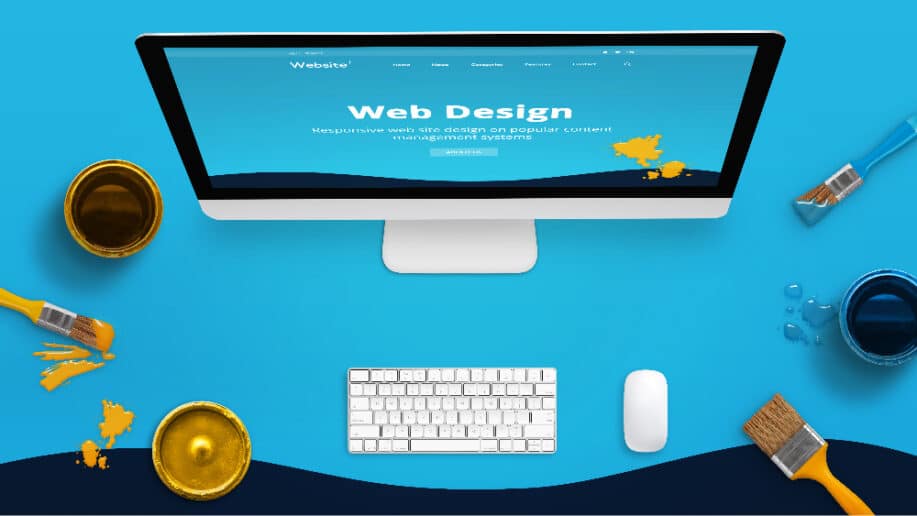In this featured post we will look at how to improve user experience (UX) along with increasing conversions through 6 important guidelines and best practices regarding web design.
When you log onto a website, chances are, you aren’t judging the placement of words, buttons, and menus. You probably aren’t there to judge the design. However, you do notice these elements of design when you shop online, read news articles, or study web design, you’re subconsciously gauging how easy it is to find what you’re looking for. If you can’t find it right away, you’ll leave.
That’s why design is such a critical element of your website. It determines whether or not you can use it, engage with it, and (most importantly) buy from it. In this article, we’ll give you a rundown of six essential web design best practices that will make your site convert more and provide a better user experience.
6 Best Practices & Website Design Guidelines
- Design for The Best User Experience (UX)
- Make Your Site Extremely Attractive
- Optimize Your Website for Mobile Devices
- Choose the Right Color Combinations
- Follow the F Pattern and “Rule of Thirds”
- Minimize Choices – To Avoid User Confusion
What is web design?

Before diving into specific design elements and best practices, it helps to answer the question of “what is web design” and why it matters. Web design includes everything that makes your website look the way it does.
Web design is not just about visuals, but also about having a engaging user interface (UI) which includes navigation structure, interactions, page layout, and more. These elements must provide the best user experience (UX) in order to keep users returning and engaging with your website.
It’s how users interact with your website to complete their tasks, learn something new, search for a product, or sign up for a newsletter. Good web design includes:
- Accessibility – Your website should be accessible to everyone regardless of ability or challenge. It needs to meet Web Content Accessibility Guidelines (WCAG).
- Intuitive – Users should be able to find information easily without thinking too hard. Your navigation and labeling should be clear and consistent.
- Responsive – Mobile devices now account for the majority of web traffic, so your website needs to work on every device size and orientation.
- Engaging – Graphics, animations, videos, and other interactive elements can help make your website more engaging and memorable.
- Fast – Your pages should load quickly, especially on mobile devices. Make sure to optimize site speed by compressing images and leveraging caching techniques.
- Secure – Your website needs to use SSL encryption to protect user information and keep them safe from hackers.
- SEO-optimized – Ensure your content is optimized with the right keywords and headings to help your pages rank higher in search engine results.
The Guidelines & Best Practices for Web Design

Bad UX turns your site traffic away. But an exceptionally-designed website can actually help you sell more. Up to 400% more. Understanding web design standards and best practices will help to guide your steps in each phase of the design process.
1. Design for User Experience (UX)
To avoid common UX problems, your website must have some important elements in place. Let’s picture the website as a restaurant for a moment. The site’s structure (its coding and development) is the kitchen, where all the cooking and behind-the-scenes work happens.
However, what’s out front (the presentation of the food, the ambiance, the service) is web design. In this example, the overall dining experience, which really is how smoothly everything works together for the customer, would be considered user experience (UX) in website design.
UX is like the secret sauce that can turn a one-time diner into a regular patron. It encompasses every interaction a user has with your website, from the moment they arrive to the moment they leave. Just like a restaurant experience, if it’s enjoyable and seamless, they’ll spend more while they’re there and come back again later. The most important UX elements include:
- Content: Make sure your content is written in a way that’s easy to understand and digest.
- Navigation: Build intuitive navigation elements, like menus and breadcrumbs, to help users find what they need quickly.
- Interactions: Add dynamic elements like hover effects and animations to guide users through your site and lead them to the right information. Use internal linking to help them access related content in one click.
2. Make Your Site Attractive
A beautiful website is more inviting and trustworthy. Investing in quality visuals and graphics can make your pages look clean, professional, and aesthetically pleasing. Stanford’s Web Credibility Project explains this concept perfectly.
The Persuasion Technology Lab at Stanford University examined the most significant website elements impacting perceived website credibility.
The organization found that “design look” accounted for 46.1% of the factors considered, meaning people care first about a website’s design quality and next about its actual information. A few elements determine whether or not your site visitors will see your site as “attractive”:
- White space: White space is a design area not occupied by text or images. It provides breathing room and helps your content stand out.
- Typography: Keep your font choices consistent and readable and limit the number of typefaces you use. Only use black or dark gray for text color (or white on a dark screen).
- Color: Choose a limited color palette with no more than four main colors representing your brand.
- Imagery: Images are processed 60,000 times faster than plain text. If you want to get your point across, your copy and visuals should complement one another, and visuals should do most of the heavy lifting.
3. Optimize for Mobile
Today, 55% of website traffic comes from mobile devices. This means that over half the people visiting your website are likely doing so from a phone or tablet. Globally, 92.3% of internet users access information from their phones at least some of the time, meaning there are about 4.32 billion mobile internet users.
Since nearly everyone browses the web on their phones, Google decided to adjust its approach to delivering this information. Google’s mobile-first indexing sounds technical, but all it means is that Google predominantly uses the mobile version of a site’s content for indexing and ranking. This isn’t just for a few sites; mobile-first indexing is the standard.
Mobile compatibility isn’t just about resizing content to fit a smaller screen (though that’s part of it). It’s about considering how people interact with mobile devices differently than desktops. Think about it: they’re using touch controls rather than a mouse, likely juggling other tasks, and often dealing with slower internet speeds.
A mobile-optimized site needs to be designed with these constraints in mind. It should have large, easily tappable buttons, a clear and simplified navigation structure, and be speed-optimized to account for potentially slower mobile data connections.
4. Choose the Right Colors
Color is a powerful tool. It’s more than just visual dressing; it’s a silent communicator, subtly influencing our perceptions and emotions. When it comes to web design, the importance of color choice cannot be overstated.
The Institute for Color Research found that between 62% and 90% of our initial impressions of a product or environment are based on color alone. Kissmetrics research on color psychology supports this, revealing that more than half (52%) of web users wouldn’t return to a site if they found its color palette unappealing.
If more than half of your visitors leave due to color choice, you know you’re doing something wrong. The key is choosing color combinations that look attractive and align with your brand identity and the mood you want to convey. Here are a few examples:
- Luxury brands tend to opt for dark, muted colors like navy or black to evoke a sense of sophistication.
- Feminine brands typically choose pastels and light hues like pink, lavender, and mint green.
- All-natural products feature greens, blues, and browns to denote a connection with nature.
- Social media platforms use blue to make their users feel calmer and more conversational.
Depending on the type of brand or website you’re creating, the colors you choose should complement your message and create an emotional connection with your users.
5. Follow the F Pattern and Rule of Thirds
The F pattern resembles the letter “F”. Eye-tracking research from Nielsen Normal Group shows that users typically start at the top left corner of a page and move across to the right, creating the top bar of the “F”. Then, they scan down the page before moving across again, forming the lower bar.
Since the upper left quadrant is where users’ eyes land first, expert UX designers from agencies like Bizango ensure it makes a strong first impression, including key information and conversion points (a headline, brand logo, or call-to-action).
The rule of thirds suggests breaking your page into nine equal parts and placing the most important elements (such as headlines, logos, and images) along the lines that divide the space. This helps create a visually balanced design that captures users’ attention.
Imagine a tic-tac-toe grid placed over your webpage, dividing it into thirds both horizontally and vertically. The four intersection points in the center of this grid are the areas where users’ eyes are naturally drawn. Those points are where your most important content belongs.
6. Minimize Choices
The Paradox of Choice is an age-old adage that describes how “more isn’t always better.” Too many choices can cause analysis paralysis; that is, users become overwhelmed and don’t make a decision at all. To avoid this, focus on the user experience by minimizing the number of choices presented at once.
When creating your website, think about what information is absolutely essential and remove the fluff. When it comes to suggestions (other content, product, or services to view), only show three at once.
Final Thoughts

Following these web design guidelines and best practices can help you create a website that looks great, functions well, and engages the users. Using these six best practices can turn your site into a conversion-driving machine. Whether you’re creating a new site from scratch or revamping an existing one, these tips will ensure you have the best chance of success.


Hey there, fellow web design enthusiast! I just finished reading your article on the best web design practices, and I must say, it was an absolute joy to read. Your insights and tips are truly on point, and I couldn’t agree more with everything you mentioned. I’ve always been on the lookout for valuable resources to enhance my skills, and your article certainly hit the mark.
Your emphasis on responsive design and mobile optimization resonated deeply with me. As today people are constantly on their mobile devices, and creating websites that adapt seamlessly to different screen sizes is not just important, but crucial. Your practical advice and examples on how to achieve this are incredibly helpful, and I can’t wait to implement them in my future projects.
I also appreciated your thoughts on the importance of user experience. Designing with the end-user in mind is something every web designer should take to heart. Your explanation of how small details like intuitive navigation, clear call-to-actions, and thoughtful content placement can make a world of difference is spot on. Your article has inspired me to double down on the user-centered approach and strive to create websites that not only look stunning but also offer an exceptional user journey.
Keep up the fantastic work, and I’ll definitely be on the lookout for more of your articles in the future! Cheers!